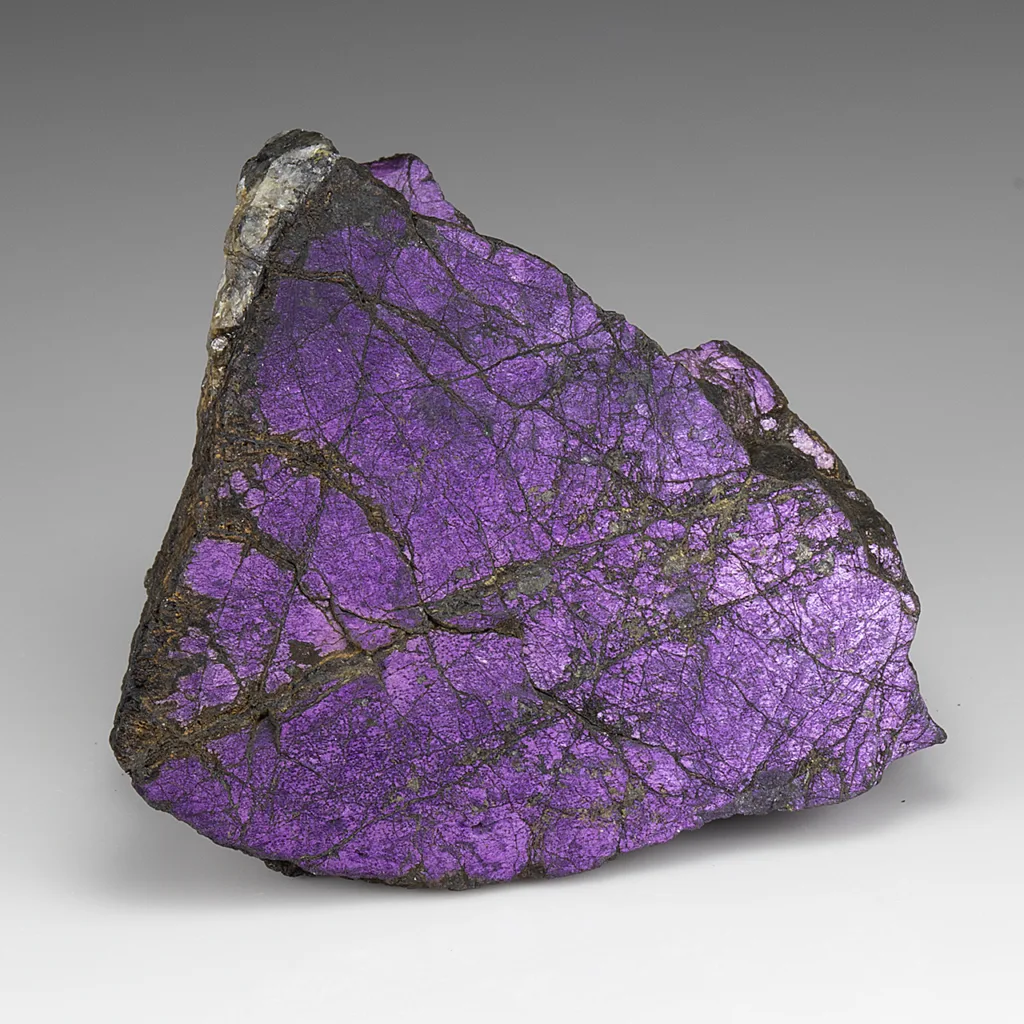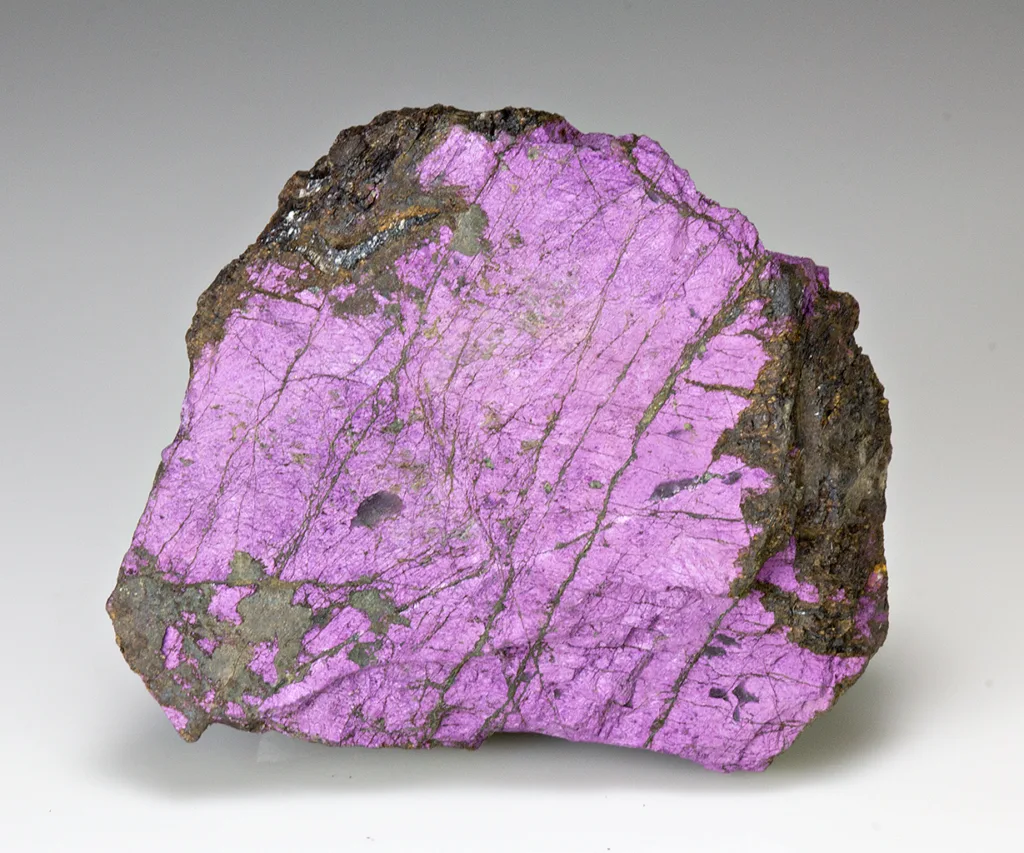Purpurite is a mineral that belongs to the phosphate group. Its name is derived from the Latin word “purpura,” meaning purple, owing to its characteristic color. It typically occurs in shades of purple, ranging from pale lavender to deep violet. The mineral is primarily composed of manganese phosphate, with the chemical formula MnPO4·H2O. Its composition may also contain traces of iron, magnesium, calcium, and aluminum.

Purpurite is classified as a secondary mineral, formed through the alteration of primary manganese-bearing minerals in phosphate-rich environments. It is commonly found in association with other manganese minerals such as triphylite, lithiophilite, and various phosphates.
Beyond its geological significance, purpurite is valued for its aesthetic appeal and is often sought after by mineral collectors and lapidaries for use in jewelry and ornamental purposes. Its vibrant purple hues make it an attractive gemstone when cut and polished.
In addition to its decorative applications, purpurite has been studied for its potential economic importance due to its manganese content. Manganese is a vital industrial metal used in the production of steel, batteries, and various alloys. However, the commercial exploitation of purpurite for manganese extraction is limited due to its relatively low abundance and the presence of other manganese sources that are more economically viable.
Overall, purpurite is a visually striking mineral with both geological and aesthetic significance, embodying the intriguing interplay between geological processes and natural beauty.
Occurrence and distribution in nature

Purpurite is primarily found in association with manganese-bearing minerals in phosphate-rich environments. It typically occurs in granite pegmatites, which are coarse-grained igneous rocks formed during the final stages of magma crystallization. These pegmatites often contain a diverse range of minerals, including phosphates, and provide favorable conditions for the formation of purpurite.
Aside from pegmatites, purpurite can also be found in other geological settings such as hydrothermal veins, where hot water solutions deposit minerals in fractures and cavities within rocks. Additionally, it may occur as a secondary mineral in sedimentary deposits formed through the weathering and alteration of primary manganese ores.
The distribution of purpurite in nature is relatively widespread, but it is not as abundant as some other manganese-bearing minerals. Significant occurrences of purpurite have been reported in various countries around the world, including:
- Brazil: Purpurite has been found in pegmatites in Minas Gerais and other regions known for their rich mineral deposits.
- Namibia: Deposits of purpurite have been discovered in pegmatites and hydrothermal veins in areas such as the Erongo Region.
- United States: Purpurite occurrences have been reported in several states, including California, Colorado, Maine, and New Hampshire.
- Australia: Notable occurrences of purpurite have been recorded in Western Australia, particularly in regions known for their pegmatite-rich geology.
- Portugal: Purpurite has been found in pegmatites in the northern part of the country, including areas near Viseu.
These are just a few examples, and purpurite may also be found in other countries with suitable geological conditions. Despite its relatively widespread occurrence, purpurite is not commonly mined for industrial purposes due to its limited abundance and the availability of more economically viable sources of manganese. However, it remains an intriguing mineral for collectors and enthusiasts due to its vibrant color and unique geological associations.
Geological Formation

Purpurite forms through geological processes involving the alteration of primary manganese-bearing minerals in phosphate-rich environments. The formation of purpurite typically occurs in several stages and is influenced by various factors such as geological conditions, temperature, pressure, and the presence of reactive fluids.
- Primary Manganese Mineral Formation: Purpurite often originates from primary manganese minerals such as lithiophilite, triphylite, and other manganese-bearing phosphates. These minerals are commonly found in igneous rocks like granite pegmatites, which provide the initial source of manganese.
- Weathering and Alteration: Over time, primary manganese minerals undergo weathering due to exposure to atmospheric conditions, groundwater, and chemical reactions. This weathering process breaks down the primary minerals, releasing manganese ions and phosphate ions into the surrounding environment.
- Phosphate-Rich Environments: Purpurite formation occurs in phosphate-rich environments where phosphorus is readily available. This can include areas with phosphate-rich sediments, hydrothermal solutions carrying phosphorus, or regions with elevated levels of phosphate minerals.
- Hydrothermal Activity: In some cases, hydrothermal fluids rich in phosphorus and manganese infiltrate fractures and cavities within rocks. These fluids may precipitate purpurite along with other secondary minerals as they cool and react with the surrounding rock matrix.
- Secondary Mineral Precipitation: As manganese and phosphate ions accumulate in the environment, they react to form secondary minerals like purpurite. The exact conditions of temperature, pressure, pH, and the presence of other ions influence the specific crystal structure and morphology of the purpurite crystals.
- Coloration: The distinctive purple color of purpurite is attributed to the presence of manganese ions within its crystal lattice. The intensity of the purple hue can vary depending on factors such as manganese concentration, crystal size, and impurities.
Overall, the formation of purpurite is a complex geological process involving the alteration and precipitation of minerals under specific environmental conditions. While purpurite is not as abundant or economically significant as some other manganese minerals, its formation provides insights into the geochemical processes operating within Earth’s crust.
Physical Properties

Purpurite possesses several physical properties that contribute to its identification and characterization. Here are some of its key physical properties:
- Color: Purpurite is typically recognized for its distinctive purple coloration, which can range from pale lavender to deep violet. The intensity of the purple hue may vary depending on factors such as manganese concentration and crystal quality.
- Luster: The luster of purpurite is often described as vitreous to dull. Vitreous luster refers to a glassy or shiny appearance, while dull luster appears more matte or lacking in shine.
- Transparency: Purpurite is commonly translucent to opaque, meaning that light may or may not pass through the mineral depending on its crystal structure and impurities.
- Crystal Habit: Purpurite typically forms as botryoidal, reniform, or massive aggregates. Botryoidal specimens exhibit rounded, grape-like formations, while reniform specimens have a kidney-like appearance. Purpurite crystals may also occur in granular or fibrous masses.
- Hardness: Purpurite has a Mohs hardness of around 4 to 5. This places it in the range of typical hardness for phosphate minerals. It is harder than gypsum but softer than common minerals like quartz and feldspar.
- Cleavage and Fracture: Purpurite may exhibit poor to absent cleavage, meaning it does not break along well-defined planes. Instead, it tends to fracture unevenly, producing irregular or jagged surfaces.
- Density: The density of purpurite varies depending on factors such as composition and porosity but typically ranges from 3.0 to 3.3 grams per cubic centimeter (g/cm³).
- Streak: The streak of purpurite, observed by rubbing the mineral across an unglazed porcelain streak plate, is often colorless to pale purple.
- Twinning: Twinning, the intergrowth of two or more crystal individuals, is occasionally observed in purpurite crystals.
- Fluorescence: Some purpurite specimens may exhibit fluorescence under ultraviolet (UV) light, emitting visible light in response to UV radiation.
These physical properties, along with chemical composition and geological context, help mineralogists and geologists identify and classify purpurite specimens in both natural and laboratory settings.
Uses and Applications

Purpurite, while not as widely utilized as some other minerals, has several potential uses and applications:
- Gemstone and Jewelry: Purpurite’s attractive purple color and relative rarity make it desirable for use in jewelry. When cut and polished, purpurite can be incorporated into various jewelry pieces such as pendants, earrings, and rings.
- Mineral Collecting: Purpurite’s unique color and crystal formations make it a sought-after specimen among mineral collectors and enthusiasts. Collectors value purpurite for its aesthetic appeal and geological significance.
- Metaphysical and Healing Properties: Some individuals believe in the metaphysical properties of purpurite and use it for spiritual purposes. It is thought to promote inner peace, creativity, and spiritual growth. However, these beliefs are not supported by scientific evidence.
- Manganese Source: Purpurite contains manganese, a vital industrial metal used in the production of steel, batteries, and various alloys. While purpurite is not commonly mined for manganese due to its limited abundance and the availability of more economically viable sources, it may still contribute to the overall manganese supply.
- Pigments and Dyes: Historically, certain purple pigments and dyes were derived from minerals like purpurite. While synthetic alternatives are more commonly used today, purpurite’s natural purple color could potentially be utilized in artistic and cosmetic applications.
- Research and Education: Purpurite, like many minerals, serves as a subject of study in geological research and educational settings. Its formation, composition, and occurrence contribute to our understanding of geological processes and mineralogy.
- Ornamental and Decorative Use: Beyond jewelry, purpurite can be used for ornamental purposes such as decorative objects, sculptures, and lapidary art. Its unique color and texture make it a distinctive material for artistic creations.
While purpurite may not have as many industrial applications as some other minerals, its aesthetic appeal and geological significance ensure that it remains valued among collectors, artists, and researchers.
Industrial applications

Purpurite, despite its relative rarity and limited abundance, has some industrial applications, primarily due to its manganese content. Manganese, one of the key constituents of purpurite, finds use in various industrial sectors. Here are some potential industrial applications of purpurite:
- Steel Production: Manganese is a crucial alloying element in the production of steel. It improves the strength, hardness, and durability of steel, making it suitable for applications in construction, automotive manufacturing, and infrastructure development. Purpurite, if mined and processed for its manganese content, could contribute to the production of manganese alloys used in steelmaking.
- Batteries: Manganese is utilized in the production of batteries, particularly alkaline batteries and lithium-ion batteries. These batteries are widely used in electronic devices, electric vehicles, and renewable energy storage systems. Purpurite-derived manganese could potentially be used in battery manufacturing processes.
- Alloys and Metallurgy: Manganese alloys, such as ferromanganese and silicomanganese, are used in metallurgical applications. These alloys are added to steel and non-ferrous metals to impart desirable properties, such as corrosion resistance, hardness, and high-temperature stability. Purpurite-derived manganese could be processed into manganese alloys for various metallurgical applications.
- Chemical Industry: Manganese compounds derived from purpurite may find applications in the chemical industry. Manganese oxides, for example, are used as catalysts, pigments, and in the production of fertilizers, ceramics, and glass. Purpurite could serve as a potential source of manganese for such applications.
- Water Treatment: Manganese compounds are sometimes employed in water treatment processes, particularly for the removal of contaminants like iron, hydrogen sulfide, and arsenic from drinking water and wastewater. Purpurite-derived manganese compounds may be utilized in water treatment facilities for this purpose.
- Catalysis: Certain manganese compounds exhibit catalytic properties and are employed in various catalytic processes, including oxidation reactions and environmental remediation. Purpurite-derived manganese compounds could be explored for catalytic applications in chemical synthesis and pollution control.
While purpurite’s industrial applications are somewhat limited compared to more abundant manganese sources, its utilization in specific niche markets or high-value applications may still be feasible, especially considering its unique properties and geological significance. However, economic viability and sustainability considerations would need to be assessed carefully for any potential industrial exploitation of purpurite.




































